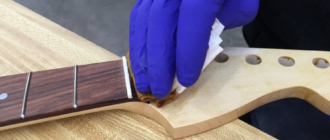When you’re in the guitar shop to buy a guitar, the finish is an important consideration. Can you play guitar? Do you want a satin guitar finish or a shiny finish?
There are pros and cons to each option. Satin finishes are matte and light shine. Satin guitars tend to reflect less light than gloss finishes, which makes them less likely to show damage. The gloss guitar is textured with a clear appearance. Minor imperfections stand out more than they do on satin finishes.
So, which is the better option? Ultimately, it’s up to you. A guitar will last for many years, so you need to make the decision that’s best for you. Consider your lifestyle and the type of environment you’ll be playing in.
If you’re hard on your instruments, a satin finish may be a better option. If you care about the appearance of your guitar, go with a gloss finish.

What is a satin finish guitar?
A satin finish guitar is a guitar that has been coated with a light matte finish. This finish is less reflective than a glossy finish, which makes it a popular choice for those who want a guitar that is less likely to show scratches and other minor imperfections.
It also tends to be less expensive to produce than gloss-finish guitars. You just dust or clean it from natural oils with a microfiber cloth or any other soft cloth.

The different types of finishes
Guitar finishes come in a variety of types each with its unique properties. Here are the most common types of finishes:
- Satin guitar finish: one of the matte finishes that has a light shine. It is less reflective than a gloss guitar finish and is less likely to show minor imperfections.
- Gloss guitar finishes: a shiny, textured finish that gives guitars a clear appearance. Minor imperfections are more visible on gloss-finish guitars than on satin guitars. One of the features found on many Taylor guitars is a glossy guitar finish.
- Lacquer finish: a high-gloss finish that is applied in layers. It is the most durable type of guitar finish and is also the most resistant to scratches and dents.
- Paint finish: a low-gloss finish that is applied in one or two coats. It is less durable than other types of finishes and is prone to scratches and chipping.
Gloss guitars vs. satin finish guitars
It can be tough to choose between a satin finish and gloss guitars. They both have their benefits and drawbacks.
Gloss finish guitars
A gloss finish guitar is textured with a clear appearance. Minor imperfections appear, but they can easily be polished away using a thin layer of guitar polish and a microfiber cloth, for example.
It appears more aesthetically pleasing to the eye because the gloss finish adds more wood grain. Gloss-finish guitars are very shiny and reflect light very well. This makes gloss finish guitars very visible on stage and can be a distraction for the performer.

Satin finish guitars
The satin guitar has a matte, light shine. The satin guitar is less reflective in its finish and this enables it to reduce its cost by reducing damages. The satin guitar is not as shiny as a gloss finish guitar and it is not as visible on stage.

Benefits of satin finish guitars
Satin finish guitars have a lot of benefits, and if you’re looking for an affordable option, this is one to consider. Firstly, the matte and light shine of the satin finish allows for less reflection and can help reduce any accidental damage.
This makes it a great option for playing live shows or jamming with friends since it’ll be more resistant to wear and tear in comparison to gloss-finished guitars.
Satin finishes also don’t require as much maintenance as gloss finishes do — all you need is a clean cloth to wipe away dust and debris, and you’re good to go. Plus, they have a nice subtle texture that can help bring out the guitar’s natural beauty while still maintaining a low-key look.
Guitarists prefer satin finish necks over glossy necks. These necks aid in the smooth movement of the left hand through the neck. The reason for this is that these necks become less oily. As a result, no sticky neck. Friction is caused by oily and sticky necks.
In short, satin finish guitars are good options if you’re looking for something functional and affordable — something that looks good but won’t break the bank or require too much maintenance.

Disadvantages of satin finish guitars
Although satin finish guitars offer many advantages, there are some potential drawbacks you should consider. One might be that the matte finish can make it difficult to read scratches and dings. That means that visible damage may be hard to identify when it comes time to sell or trade in your instrument.
In addition, getting a more accurate reflection of your guitar’s playing performance is more difficult with a satin finish because, again, the matte nature of the finish makes it harder to reflect sound accurately.
So if you need an instrument that offers the clearest sound possible and an easier way to discern damage from wear and tear, then it’s probably best to opt for a glossy finish instead.

Choosing the right tone with satin finish guitars
When trying to decide between the two options, it is important to keep the tone of your guitar in mind. The gloss finish will have a brighter sound, while the satin finish has a slightly softer tone that may be ideal for certain types of music.
So if you’re looking for a softer sound, the satin finish may be a better option. Additionally, because it is less reflective, it can help reduce resonance and feedback so you can get a cleaner tone without too much buzzing or humming.
The feel of the guitar is also important to consider when deciding between a gloss or satin finish. The smoother texture of the gloss finish may be more enjoyable for some players as it feels smoother on both hands.
On the other hand, the satin finish has an almost velvety texture that can feel nice to play with and will not become too slick with sweat during long practice sessions. Ultimately, it comes down to personal preference.

Maintenance tips for satin finish guitars
You may decide to go with a satin finish guitar, and that’s great news! Before you make your purchase, it’s important to understand the proper maintenance guidelines for keeping your satin finish guitar in top condition.
First and foremost, you want to avoid polishing the guitar. The purpose of a satin finish is to reduce reflection and shine, so using a guitar polish will defeat the purpose! For guitar cleaning use a clean microfiber cloth – preferably one specifically made for musical instruments – and just give your guitar body a light dusting when necessary.
Another tip is to make sure to keep your guitar away from extreme temperatures or humidity. Satin finishes can be easily affected by changes in temperature or humidity levels, so try to keep those levels as consistent as possible to avoid any damage to the satin finish.
Finally, be sure to store your guitar properly when not in use. An acoustic-electric guitar case works best for this; it’ll protect your instrument from minor scratches and dents that can affect the integrity of its satin finish.

Gloss vs. satin fretboards
If you want something with more heavy metal sounds then the glossy would work better. Minor imperfections won’t be visible, but they will also show dust and fingerprints more easily. Both fretboards are good options if you want to get a quality guitar.

Best satin finish guitar brands on the market
Ibanez and Fender produce some of the best satin finish guitars on the market. Other brands like Gibson, Taylor, and Epiphone offer great options as well. No matter what kind of player you are or what sound you’re looking for, there’s something from one of these top brands to suit your needs.

Best uses for satin finish guitars
Satin finishes are great if you’re looking for a clean look that won’t have too much shine or reflectivity. This can be beneficial in gigging scenarios, as it’s less likely to draw attention away from your playing. Since satin finishes are less reflective, they don’t require as much maintenance and polishing to keep them looking their best.

Acoustic guitars
The thickness of the material used for the guitar finish is what affects the tone of an acoustic guitar. The overall tone of the guitar is also affected by how well the finish is applied. A finish, when applied expertly and at just the right thickness, can enhance the sound of a good guitar.
Sonically, any differences in the sound of the guitar caused by the finish will be more noticeable on acoustic guitars rather than electrics. This is simply because an electric guitar signal, as opposed to an acoustic guitar, goes through a lot more processes before it is heard.

FAQs
Are satin finishes on guitars good?
Since satin surfaces are less greasy they can also play more smoothly on the stage. Guitars are available in various finishes from satins to glosses. The guitar finishes may cause a slight difference in sound, but this cannot be detected.
What is a satin finish on a guitar?
Satin finish or a matte finish gives guitars a matte appearance with a rougher feel. These finishes don’t bring up the wood grain as strongly. Similarly, satin finishes are worn out over a period leaving certain sections shiny.
What are the pros and cons of a satin finish guitar?
Satin guitars have a thin coating. It looks like an older-school product and remains cleaner for longer. Satin guitars can also resist fingerprint stains. Matt guitars may suffer weather changes, humidity changes, or damage.
Can you polish a satin finish guitar?
The look of satin guitars should never appear glam. Guitars like those can withstand extreme temperatures. The guitars cannot be polished. You need just lukewarm water and a microfiber cloth.
Are satin-finished guitars durable?
Satin-finished guitars are very durable. The lack of gloss makes them less reflective and more resistant to scratches and damage. Plus, added resin makes them fireproof, and waterproof, and helps with adhesion.
Is a satin finish guitar suitable for performing?
Yes, it is most definitely! Satin finish guitars are just as suitable for performing as their gloss counterparts, with minor imperfections not being very noticeable in the stage light.
What types of sounds do satin finish guitars produce?
Satin-finish guitars tend to have a warmer guitar sound since they are more responsive when you strum or pluck the strings. The sound is also less metallic since it has been lightly textured and not heavily polished as gloss finishes tend to do.
Conclusion
In the end, the decision of a satin or gloss finish guitar is a personal one, based on the individual player’s wants and needs. There are benefits and drawbacks to both finishes, and it ultimately comes down to which one the player prefers the look and feel of.
No matter which finishes you choose, be sure to take care of your guitar with the proper materials like microfiber cloth and techniques, to keep it in good condition for years to come.
Read also: The ultimate guide on how to repair guitar neck binding






